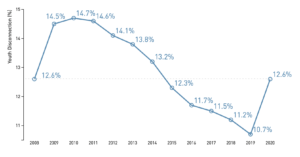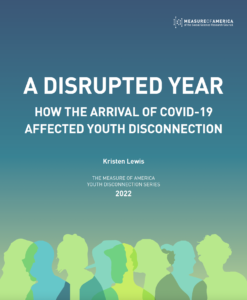A Disrupted Year: How the Arrival of Covid-19 Affected Youth Disconnection
To see the most recent data, check out our interactive tool on youth disconnection.
LAUNCHED MARCH 31, 2022
FULL REPORT | INTERACTIVE TOOL | MEDIA RELEASE| LAUNCH WEBINAR
On the eve of the Covid-19 pandemic, the number of teens and young adults disconnected from both work and school in the United States was lower than it had been in over a decade. Between 2010 and 2019, the youth disconnection rate fell 27 percent, driven largely by the steady increase in youth employment in the years following the Great Recession. The 2020 national youth disconnection rate is 12.6 percent, or 4,830,700 disconnected youth—an upward spike that reverses a decade-long trend of falling rates. The rate increase signals a Covid-fueled reversal of the decade-long decline in the share of the country’s young people neither working nor in school. In addition, due to Covid-related data challenges, the report argues that this rate is likely an underestimate of the true extent of disconnection in the first year of the pandemic; in other words, the youth disconnection rate for 2020 is at least this high and very likely higher.
A Disrupted Year: How the Arrival of Covid-19 Affected Youth Disconnection is the latest in Measure of America’s series of annual reports on teens and young adults ages 16–24 years who are neither working nor in school, a group referred to as disconnected youth or opportunity youth. The youth disconnection rate is a vital metric of access to opportunity and societal well-being. People acquire skills, credentials, habits, and experiences fundamental to a rewarding, productive, and joyous life during their teens and early twenties. The youth disconnection rate thus tells us which young people in our society have the chance to lay the groundwork for freely chosen, flourishing lives and which groups face serious challenges in the transition to adulthood. Research shows that being disconnected as a young person has long-term consequences; it’s associated with lower earnings, less education, worse health, and even less happiness in later adulthood. Determining who remains disconnected, and why, is vital to identifying strategies and interventions, especially in the wake of the Covid-19 pandemic.
The Covid-19 pandemic continues to pose countless health, educational, and economic challenges. The events of 2020 deprived America’s young people of a host of experiences that would have allowed them to build the capabilities required to live flourishing lives as adults. In addition, the burden of the Covid-19 pandemic has fallen disproportionately on low-income communities of color, which are also disproportionately home to the highest rates of youth disconnection.
A Disrupted Year presents 2020 youth disconnection rates for the United States as a whole as well as by gender, race and ethnicity, region, state, metro area, and congressional district. The report also offers recommendations on how to better serve out-of-school and out-of-work young people.
KEY FINDINGS
 National rate: The 2020 youth disconnection rate is 12.6 percent, or 4,830,700 young people.
National rate: The 2020 youth disconnection rate is 12.6 percent, or 4,830,700 young people.- Data challenges: The onset of the Covid-19 pandemic severely disrupted the federal statistical collection and curation processes. These disruptions resulted in lower American Community Survey response rates not only from the very groups most likely to be out of school and work, such as low-income, Black, and Latino households, but also during the initial months of the pandemic, when the economy shed literally millions of jobs. Although the Census Bureau took several steps to shore up the 2020 survey data by cross-referencing additional government data sources, the Bureau nonetheless released these data with a host of caveats and urged users to exercise caution when making comparisons to previous years’ data. These caveats suggest that the estimates we provide in this report understate the magnitude of youth disconnection in 2020; we believe that the actual rates, in other words, are at least this high and likely higher. That said, these data are still the most comprehensive and reliable available.
- Gender: As in past years, girls and young women are less likely to be disconnected than boys and young men, 12.1 percent versus 13.2 percent. The size of the gender gap varies by race and ethnicity, however.
- Race and ethnicity: Nearly one in four Native American teens and young adults are neither working nor in school. The Native American youth disconnection rate is 23.4 percent, the highest of the United States’ five major racial and ethnic groups. Black teens and young adults have the second-highest disconnection rate, 19.6 percent, or 982,900 young people. Black young people have the largest gender gap in the youth disconnection rate of any racial or ethnic group—16.6 percent for Black girls and young women, compared to 22.5 percent for their male counterparts. The Latino youth disconnection rate stands at 14.0 percent, or 1,258,700 young people. In past years, Latina girls and young women were slightly more likely than their male counterparts to be disconnected, but in 2020, the male and female rates were the same, 14.0 percent. The disconnection rate for white teens and young adults is 10.6 percent, the second-lowest rate. White teens and young adults make up the largest absolute number of disconnected youth, 2,087,800 people. Asian teens and young adults have the lowest disconnection rate, 7.3 percent, or 156,100 young people. Rates vary widely by Asian subgroup and gender, however, from a low of 4.5 percent for Chinese and Japanese boys and young men to a high of 18.8 percent for Cambodian boys and young men.
- Regions: The West South Central region, which comprises Arkansas, Louisiana, Oklahoma, and Texas, has the highest disconnection rate of any region in the United States, 14.6 percent. The West North Central region has the lowest disconnection rate of all US regions, 9.9 percent; it is home to seven states: Iowa, Kansas, Minnesota, Missouri, Nebraska, North Dakota, and South Dakota.
- States: Nebraska has the lowest youth disconnection rate (7.8 percent), followed by New Hampshire (8.3 percent) and Minnesota (8.6 percent). New Mexico has the highest rate (19.6 percent), followed by Alaska (19.5 percent) and Arkansas (17.4 percent).
- Metro areas: Provo-Orem, UT (6.9 percent), boasts the lowest youth disconnection rate of the 100 most populous metro areas in the country, followed by San Jose-Sunnyvale-Santa Clara, CA (7.0 percent), and Madison, WI (8.2 percent). Although Madison has one of the lowest rates overall, the rate for Black young people in that metro area is very high, 21.2 percent. The highest youth disconnection rate can be found in Albuquerque, NM (19.7 percent), followed by Bakersfield, CA (19.6 percent), and McAllen-Edinburg-Mission, TX (18.8 percent).
- Congressional districts: California’s 52nd congressional district, which includes the bulk of the city of San Diego, has the lowest youth disconnection rate (5.3 percent). Michigan’s 14th congressional district, which includes some of the lowest-income neighborhoods in Detroit, is home to the highest youth disconnection rate, 25.0 percent.
For media and all other inquiries, contact us at: contact@measureofamerica.org
